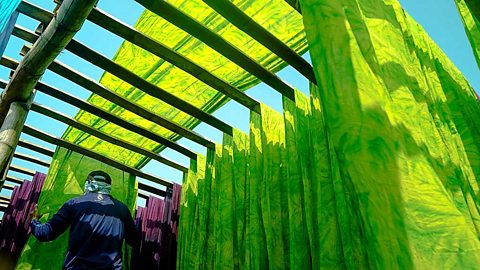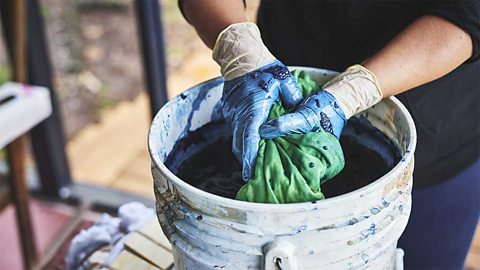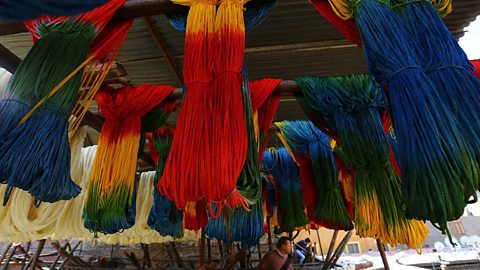Dip-dyeing
Colouring fabrics

Fabrics can be dyed at different stages of production.
Cold water dyes can be used for dyeing natural fibreA single hair-like strand that comes from a natural source. Natural fibres are either plant, eg cotton, or animal, eg wool, in origin. such as cotton, silk, linen and wool. synthetic fibreA single hair-like strand that is made from chemicals derived from oil. Synthetic fibre examples are polyester and nylon. and fabrics such as polyester, viscose and nylon need to be dyed in hot water dyes. You can also dye large pieces of fabric and textile products using special dyes in a washing machine.

Dye can also be applied using a spray bottle, sponge, paint brush or dipping into different colours to create blending of colours and ombreDyeing fabrics to have lighter roots, gradually getting darker towards the end. effects.
Materials needed:
- Dye - usually in powdered form. Follow manufacturer’s instructions to mix with water
- Water - to mix with dye
- Salt - some dyes require a mordantA chemical that fixes dye to fibres to help fix the dye to the fibres
- Fabric - washed to remove the manufacturer’s finish
- Fibres
- Yarn
- Textile product to dye
Step-by-step guide
This is the process to follow if using cold water dyes to dye natural materials:
- Mix dye following manufacturer’s instructions. Pour dye into a jug or dye bath.
- Wash fibres, yarns, fabrics or material to be dyed to make sure it is clean and to remove any impurities which could affect the dyeing process.
- Dip the material into the dye bath. Stir to ensure that all the material is evenly covered.
- Leave to soak for the desired time.
- Remove the material from the dye bath.
- Rinse material under running water until the water runs clear.
- Leave to dry.
To create an ombre effect you can dip the material into different coloured dye baths. The key is to use harmoniousGoing well together. Things that are harmonious are similar and have elements in common. or toneHow light or dark something is. Tones could refer to black, white and the grey tones between, or how light or dark a colour appears. colours so that you can dye your material from light to dark.

Dye can also be applied to the material using a paint brush, sponge, spray bottle or pipetteA tool used to release small drops of liquid to create a marbled effect of different colours in different sections.
Question
What materials can be dyed using cold water dyes?
Cold water dyes are used to dye natural fibres such as wool or cotton. Hot water dyes are for dyeing man-made fibres like nylon and polyester.